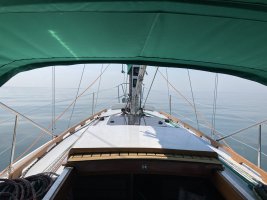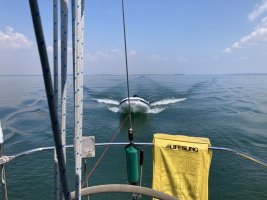I purchased a new inflatable dinghy (
https://www.westmarine.com/buy/west-marine--pru-3-performance-roll-up-inflatable-boat--14272488 ) small enough to store aboard on the foredeck or deflated in the aft quarter berth of our E32-3, which we now refer to as the “garage” because we stow stuff back there, and I also purchased a new towing bridle (
https://www.defender.com/product3.jsp?path=-1|215570|294|4099070&id=98483# ) which attached to the two forward “D” rings on the dinghy and then goes to a float where I attached a floating line that goes to the center of the transom on my E32-3. I don’t have photos of my setup but you can understand what I’m saying by just referring to the attached links. I’ve been back and forth with the “dinghy question” over the years going from inflatable, to hard shell wooden rowing dinghy, and back to inflatable which on my 32 footer seems to work out the best. We tow it most of the times but if the wind is going to be up we’ll drop it onto the foredeck, where it fits nicely, using the “Universal Dinghy Lift” (
https://www.defender.com/product.jsp?path=-1|215570|294|2345877|2345881&id=98499# ) which works great when using the spinnaker halyard.
And never, never, tow the dinghy with the motor attached because you‘re just asking for trouble. We keep our new Torqeedo (
https://www.westmarine.com/buy/torqeedo--travel-603s-electric-outboard-motor-short-shaft--20216958 ) stored below when it’s not on the dinghy. Yes, between the new manual windlass and all of the dinghy equipment we spent a bundle but now we can anchor and get ashore.



